Tag! You're it.

Everyone is so quick to take scissors to clothing tags, but I think it’s time we talk about them. What purpose do they serve? Where do they come from? Most importantly – what’s the point of these itchy little boogers anyways? Tags are the unsung heroes of the fashion industry. They tell us everything about our clothes, from what they are made of, to which brand they belong to – and they also reveal to us a critical flaw of the fashion industry.
Allow me to take you back to a time where the world was not obsessed with branding. In the 20th century, tags were a way for labor groups to slap union labels on their clothes. During the 60’s, 70’s, and 80’s, a series of legislature was passed which required clothing manufacturers to provide information about the textiles, as well as information about how to care for the clothing.
Nowadays, tags have become all about the brand, and the label on your clothing has the power to change the way that people will think about a garment as far as it’s quality and worth is concerned. Tags have power.
The fashion industry is not so innocent.
It’s critical that we start to equate the importance of looking at a clothing label with the importance of looking at a food label. This begs the question: is knowing everything about what I’m putting in my body as important as knowing everything about what I’m putting on my body? The answer: hell yes!
Think about how you felt when you found out about all of the sketchy preservatives that we didn’t know were in our food. Think about how you felt when you found out about all of the animal cruelty existing within the food industry. Well, you should be feeling the same way now, because it’s the exact same thing in the fashion industry. There is so much that we do not know about our clothes.
Image Credit: Chainpoint
When clothes are made, there’s an entire supply chain that we often forget about. Traditionally, the supply chain began with the farmer who'd shear sheep –– then moving seamlessly down the line, from woolmaker, to weaver, to tailor, ending up in a market and finally on the body of the consumer. However, it’s much more complex today, and according to fashion theory, there are now over 100 steps that comprise the supply chain.
For simplicity's sake, the supply chain has to do with absolutely everything that goes into the making of a piece of clothing –– from the worker who did the sewing, to the pilot who flew it across the ocean.
It's time to talk about credit.
When you get to the end of the movie, you sit there and watch the credits scroll through for about five minutes. If you want to find out the name of the person who trained the dog that showed up in only two scenes of the movie, I guarantee their name is on the screen. When you are at a concert, the band takes the opportunity to thank all the members, the stage crew, the lights crew, and the sound crew.
Why is the fashion industry not giving this kind of credit? Tags are about giving credit, but simply slapping a brand name on the inside of a shirt is too reductive to be considered proper accreditation, considering all of the elements that went into making that garment.
Image Credit: Francesca Coyne
So what exactly is it that our tags are telling us? Not enough! It is time that this form of strategic ignorance is called out and change needs to be made, but the question is, how? Tags could get longer and more descriptive, but that doesn’t seem to be an effective solution. People cut tags off for a number of reasons, perhaps they’re uncomfortable, they don’t want a constant reminder of the size, or maybe a branding compromises their personal style.
Tags should be telling us everything about who made our clothes and how they got to their final destination. However, it could be dangerous just to slap more and more names on tags, because it would definitely increase their chances to get snipped right off without a second thought from the consumer. It’s time we call out the industry and demand a more effective way to give proper credit that extends beyond tags on tees.








